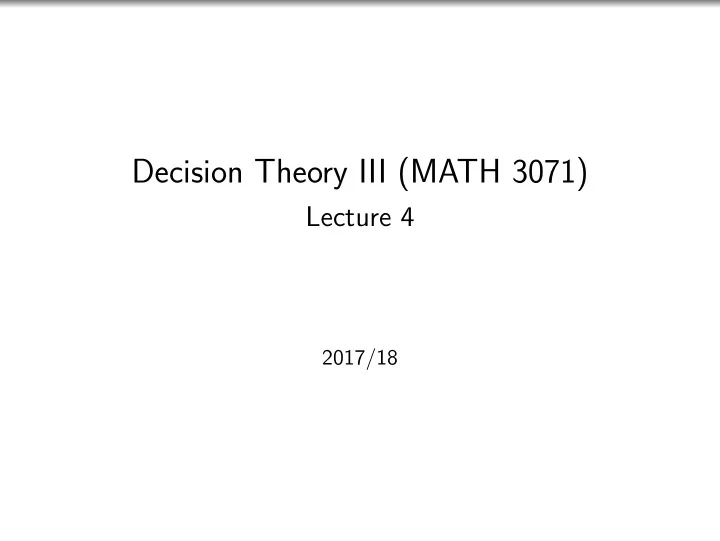

Decision Theory III (MATH 3071) Lecture 4 2017/18
Expected Money Value Expected Money Value (EMV) is the expectation of a random quantity that involves money. Expected Money Value Under Certainty (EMVUC) is the expected return if perfect information is available, that is, the expected value calculated using the best outcomes. Expected Money Value of Perfect Information (EMVPI) is defined as the difference between EMVUC and the maximum EMV .
Upgrade or overtime? Mr Ford starts producing the Model T in Manchester, and believes in big future demand. He asks you, the decision expert, whether he should upgrade his production line, or use overtime . In the upcoming year, sales can either be good or bad . If Mr Ford upgrades, then he will make a profit of £260 if sales are bad, and £440 if sales are good. On the other hand, if he chooses not to upgrade and use overtime, he will make a profit of £300 if the sales are bad, and £420 if the sales are good. According to our best judgment, sales will be good with probability 0.6 . 1. What advice would you give Mr Ford? 2. How much would Mr. Ford be willing to pay to gain acess to perfect information about sales?
Upgrade or overtime? 368 ) E 2 ( d 440 o o g 6 . 0 372 0 . 4 d 1 b ) a e d d ( E 1 260 a ) r g p u ( (overtime) ) E 2 ( 420 d o o g d 2 6 0 . 0 . 4 b a d ( E 1 300 ) 372
Upgrade or overtime? Extended Now Mr Ford has decided that he would like to plan for the future and asks you, the decision expert, whether he should upgrade his production line or use overtime for the next year (year 1), and for the following year (year 2). If we tell Mr Ford to use overtime in year 1, then we must choose overtime in year 2. If we choose to upgrade in year 1, then he can either upgrade again or use overtime in year 2. Year 1 sales can be either good or bad, with probabilities 0.6 and 0.4 respectively. In year 2, sales can be high, medium, or low. If sales in year 1 are good, then the probability of high sales in year 2 is 0.5, the probability of medium sales is 0.4, and the probability of low sales is 0.1. However, if sales in year 1 are bad, then the probability of high sales in year 2 decreases to 0.4, the probability of medium sales remains 0.4, and the probability of low sales increases to 0.2. 1. What advice can you give Mr. Ford? 2. What is the risk profile of the optimal decision? 3. How much would Mr. Ford be willing to pay for perfect information?
Extended tree H 820 M 802 790 d 1 760 L H 850 830.4 M 830.4 816 d d 2 o 790 o L G H 700 762.24 762.24 M 632 600 d 1 d 1 560 L Bad H 690 660 M 660 650 d 2 620 L H 790 M d 2 735.8 702 Good 600 L H 690 711.08 M 674 670 Bad 650 L
Risk profile In order to identify the risk profile of a solution, we: ◮ list all elementary events, ◮ calculate the probability of each of these events, and ◮ inspect the tree to find the payoff of the optimal solution for each elementary event.
Sensitivity Analysis When we are uncertain about particular numbers (payoffs, or probabilities) in our decision problem, it can be worthwile investigating how sensitive the choice of decision is to values on tree. For exameple: 4. Assume Mr. Ford isn’t so sure about the odds of good and bad sales in year 1. Solve the tree again for P ( E 1 ) = π and P ( E 2 ) = 1 − π , 0 ≤ π ≤ 1. Assuming that Mr. Ford is still maximizing EMV, what is the minimum value of π for which using overtime in Year 1 becomes the optimal decision?
St. Petersburg Paradox ◮ Put £2 in a pot and toss a fair coin. ◮ If heads, double the amount of money in the pot. If tails, the game is over and you get all the money in the pot. ◮ Repeat until you observe tails. How much would you be willing to pay to play this game once? What is the expected payoff? Should you maximize expected money value?
Recommend
More recommend